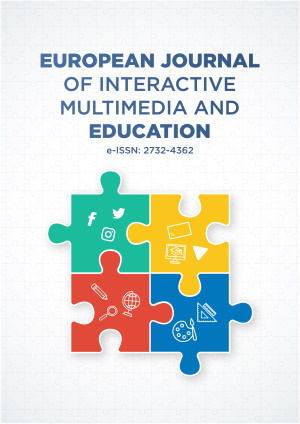Research Article
The role of multimedia tools in Hashemite Kingdom of Jordan education classroom teaching in the digital era
More Detail
1 University Utara Malaysia, Sintok, Kedah, MALAYSIA* Corresponding Author
European Journal of Interactive Multimedia and Education, 4(2), July 2023, e02303, https://doi.org/10.30935/ejimed/13378
Submitted: 16 April 2023, Published Online: 10 June 2023, Published: 01 July 2023
OPEN ACCESS 2062 Views 1376 Downloads
ABSTRACT
The article aims to reveal the role of education as a key component in the growth of nations, and it is essential for the construction of a more promising future for the nation’s youth, both as future professionals and as citizens, so that they may demonstrate their capacity to acquire the skills necessary for successful jobs. Technology development has led to the creation of many multimedia tools, which have enhanced the educational system. To boost one’s capacity for memory or understanding, one may use multimedia by combining more than one material with technology. Students, instructors, and educators need to have a solid understanding of how to use multimedia technologies that provide considerable educational advantages. This article presents an overview of numerous various kinds of multimedia tools that are used in learning and teaching. These technologies are beneficial in increasing educational quality as well as student performance in academics. Because the current generation in the coming decades is already acquainted with gadgets and other technical equipment, the educational system needs to make the most of this potential by adding multimedia tools into classroom settings.
CITATION (APA)
Alzubi, A. (2023). The role of multimedia tools in Hashemite Kingdom of Jordan education classroom teaching in the digital era. European Journal of Interactive Multimedia and Education, 4(2), e02303. https://doi.org/10.30935/ejimed/13378
REFERENCES
- Abdul Samat, M. S., & Aziz, A. A. (2020). The effectiveness of multimedia learning in enhancing reading comprehension among indigenous pupils. Arab World English Journal, 11(2), 290-302. https://doi.org/10.24093/awej/vol11no2.20
- Afyouni, B., Tabatabai, M., & Ghasempour, A. (2016). A comparative study of lecture-based and multimedia-based training methods on the second-year student’s competency in general electronics course in the technical and vocational school. Mediterranean Journal of Social Sciences, 7(4 S1), 227-227. https://doi.org/10.5901/mjss.2016.v7n4S1p227
- Aladwan, S. S. E. (2020). The use of educational technologies and modern electronic educational media in teaching science subject to grades (fourth, fifth, and sixth) and their impact on the educational process from the viewpoint of teachers at government schools affiliated with the Jordanian Ministry of Education. Ilkogretim Online [Primary Education Online], 19(2), 1254-1267.
- Ally, M. (Ed.). (2009). Mobile learning: Transforming the delivery of education and training. Athabasca University Press. https://doi.org/10.15215/aupress/9781897425435.01
- Alzubi, A. (2021). Employing multimedia in satellite channels operating in Jordan in light of unified theory of technology acceptance (UTAUT) [Doctoral dissertation, University of Petra].
- Alzubi, A. (2022). Impact of new digital media on conventional media and visual communication in Jordan. Journal of Engineering, Technology, and Applied Science, 4(3), 105-113. https://doi.org/10.36079/lamintang.jetas-0403.383
- Babiker, M., & Elmagzoub, A. (2015). For effective use of multimedia in education, teachers must develop their own educational multimedia applications. Turkish Online Journal of Educational Technology-TOJET, 14(4), 62-68.
- Baharuddin, M. F., Masrek, M. N., & Shuhidan, S. M. (2019). Innovative work behaviour of schoolteachers: A conceptual framework. International E-Journal of Advances in Education, 5(14), 213-221. https://doi.org/10.18768/ijaedu.593851
- Baharuddin, M. F., Masrek, M. N., Shuhidan, S. M., Razali, M. H., & Rahman, M. S. (2021). Evaluating the content validity of digital literacy instrument for schoolteachers in Malaysia through expert judgement. International Journal of Emerging Technology and Advanced Engineering, 11(07), 71-78. https://doi.org/10.46338/ijetae0721_09
- Chen, H. Y., & Liu, K. Y. (2008). Web-based synchronized multimedia lecture system designed for teaching/learning Chinese as a second language. Computers & Education, 50(3), 693-702. https://doi.org/10.1016/j.compedu.2006.07.010
- Eady, M. J., & Lockyer, L. (2013). Tools for learning: Technology and teaching. Learning to Teach in the Primary School, Queensland University of Technology, Australia. https://ro.uow.edu.au/cgi/viewcontent.cgi?article=1413&context=asdpapers
- Gagne. L. (2010). Telecommunications directory 21st edition. https://www.amazon.com/Telecommunications-Directory-Louise-Gagne/dp/1414448392
- Guan, N., Song, J., & Li, D. (2018). On the advantages of computer multimedia-aided English teaching. Procedia Computer Science, 131, 727-732. https://doi.org/10.1016/j.procs.2018.04.317
- Lindvall, M., Rus, I., & Sinha, S. S. (2003). Software systems support for knowledge management. Journal of Knowledge Management, 7(5), 137-150. https://doi.org/10.1108/13673270310505449
- Mayer, R. E. (2002). Multimedia learning. In B. Ross (Ed.), Psychology of learning and motivation (pp. 85-139). Academic Press. https://doi.org/10.1016/S0079-7421(02)80005-6
- Mayer, R. E. (2005). Cognitive theory of multimedia learning. The Cambridge Handbook of Multimedia Learning, 41, 31-48. https://doi.org/10.1017/CBO9780511816819.004
- Mayer, R. E., & Moreno, R. (2002). Animation as an aid to multimedia learning. Educational Psychology Review, 14, 87-99. https://doi.org/10.1023/A:1013184611077
- Mojavezi, A., & Tamiz, M. P. (2012). The impact of teacher self-efficacy on the students’ motivation and achievement. Theory & Practice in Language Studies, 2(3), 483-491. https://doi.org/10.4304/tpls.2.3.483-491
- Nusir, S., Alsmadi, I., Al-Kabi, M., & Shardqah, F. (2011). Designing an interactive multimedia learning system for the children of primary schools in Jordan. In Proceedings of the 2011 IEEE Global Engineering Education Conference (pp. 45-51). IEEE. https://doi.org/10.1109/EDUCON.2011.5773111
- Singh, R., & Awasthi, S. (2020). Updated comparative analysis on video conferencing platforms-Zoom, Google Meet, Microsoft Teams, Webex teams and Gotomeetings. EasyChair Preprint, 4026, 1-9.
- Swanson, M. D., Kobayashi, M., & Tewfik, A. H. (1998). Multimedia data-embedding and watermarking technologies. Proceedings of the IEEE, 86(6), 1064-1087. https://doi.org/10.1109/5.687830
- Xu, J. (2010). On the problems and strategies of multimedia technology in English teaching. Journal of Language Teaching and Research, 1(3), 215-218. https://doi.org/10.4304/jltr.1.3.215-218

 The articles published in this journal are licensed under the CC-BY Creative Commons Attribution International License.
The articles published in this journal are licensed under the CC-BY Creative Commons Attribution International License.